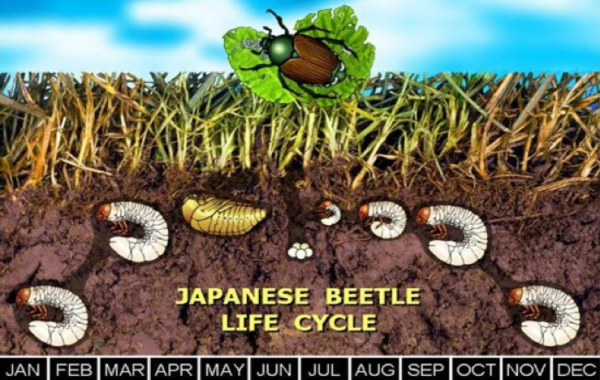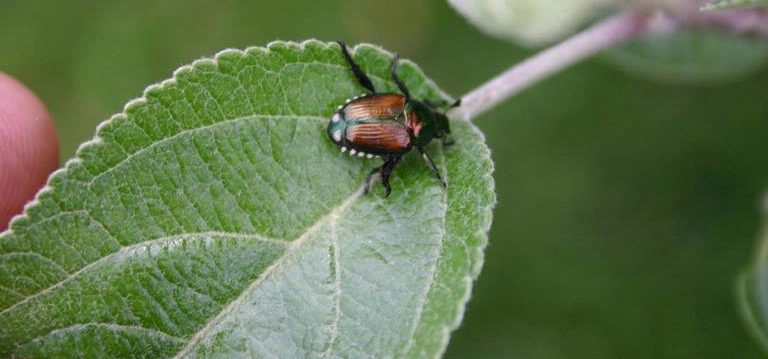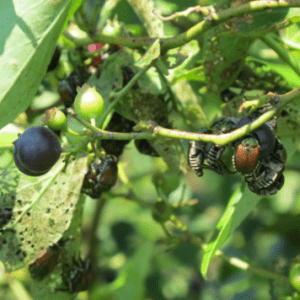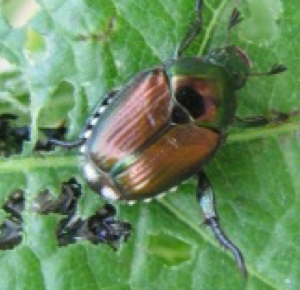Crop Production

Japanese beetles have emerged in blueberry orchards and vineyards in Central and North Alabama. The Japanese beetle (Popillia japonica) is a highly destructive plant pest native to Japan that was first found in the United States in southern New Jersey in 1916. Since then has caused considerable economic losses to numerous horticultural crops. In Japan, where the beetle’s natural enemies keep its populations in check, this insect is not a serious plant pest. In the United States, however, the beetle has no natural enemies, a favorable climate, and an abundant food supply. These conditions facilitated a gradual expansion of the Japanese beetle geographic range. In Alabama, until recently, consistent Japanese beetle populations occurred in the northern part of the state, but have moved and are currently establishing in the central and even southern part of the state.
Japanese Beetle Characteristics
The adult Japanese beetle is a little less than 1/2 inch long and has a shiny, metallic-green body with bronze-colored outer wings. The beetle has six small tufts of white hair along the sides and back of its body under the edges of its wings. The males usually are slightly smaller than the females.
Life Cycle
Adults emerge from the ground and begin feeding on plants in late-May to early-June. Activity is most intense over a 4 to 6 week period beginning in late June, after which the beetles gradually die off. An individual Japanese beetle lifespan is about 30 to 45 days. During the feeding period, females intermittently leave plants, burrow about 3 inches into the ground and lay a few eggs. This cycle is repeated until the female lays 40 to 60 eggs. By midsummer, the eggs hatch and the young grubs begin to feed. Each grub is about an inch long when fully grown and lies in a curled position. In late autumn, the grubs burrow 4 to 8 inches into the soil and remain inactive all winter. This insect spends about 10 months of the year in the ground in the larval stage. In early spring, the grubs continue to feed on roots (including turf) and in late spring, they change into pupae. In approximately two weeks, the pupae become adult beetles and emerge from the ground. This life cycle takes one year.

Japanese beetle life cycle takes a year to complete.
Damage to Crops
The adult beetles are general herbivores and are known to feed on over 400 species of broad-leaved plants, damaging leaves, flowers, and overripe or wounded fruit. Plants that are especially prone to damage include grapes, apples, roses, plums, and others. Japanese beetles can damage blueberry leaves as well. They usually feed in groups, starting at the top of a plant and working downward. The beetles are most active on warm, sunny days, and prefer plants that are in direct sunlight. The grubs will also feed on a wide variety of plant roots including trees and shrubs, garden and truck crops, as well as turfgrasses.
The adult Japanese beetles eat the leaf tissue between the leaf veins but leave the veins behind, which gives the leaves a skeletonized appearance. The adults will often attack flower buds and fruit. The grubs can kill small seedling plants but most commonly damage turf.
- Blueberry leaves skeletonized by Japanese beetles.
- Adult Japanese beetle feeding on grape leaf.
Control
It is important to keep in mind that both adults and grubs can cause damage. Since Japanese beetle adults are capable of flying in from other areas, controlling one life stage will not prevent potential problems with another life stage. Control of the grub stage requires properly timed applications of a soil insecticide to the infested site.
Visit the SE Regional Small Fruit Consortium IPM Guide for current pesticide control options in blueberries. The grape IPM Guide also contains pesticide control options. For additional reading on how to control Japanese beetles in your backyard view this APHIS webpage.
Featured Image from William Fountain, University of Kentucky, Bugwood.org



